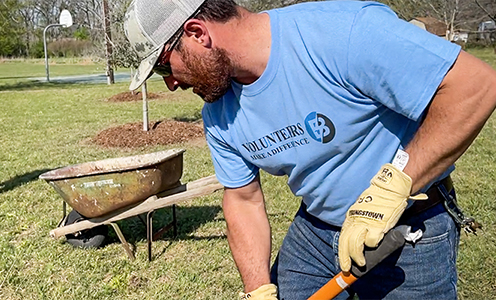Joy and Travis Tharp became newlyweds and homeowners in the same month. The twentysomethings closed on their Bastrop home in March, 2017. Their home-buying checklist included energy efficiency and ‘smart’ technology options to remotely monitor and control energy use. Sarah Beal photo
This is part of our ongoing series about 'smart living' trends.
By Sharon Jayson
Joy and Travis Tharp were excited about their first holiday season in their new Bastrop home. The twentysomethings are settling in and trying to relax a bit after the whirlwind of the last year. They married, closed on their 2,400-square-foot house and moved, all in the same month.
The Tharps, like many of their peers, had some must-haves on their home-buying checklist, including customizing construction on their two-story residence and aiming for energy savings.
“The technology we’ve used is to make our energy use more efficient and monitor our thermostat from away,” said Joy Tharp, 23.
“It’s about less overhead and more portability and affordability,” Travis Tharp, 26, said. “We want to keep our living costs lower so we can get out and enjoy life.”
For many homebuyers, the ability to customize means upgrades, but the Tharps did what they call “downgrades” to get what they wanted.
“We did no tilework in the home so we could pay for upgrades on the insulation and the windows,” he said. “We wanted more energy efficiency. We have no backsplash in the kitchen.”
They aimed to cut costs in some areas, she said, such as putting epoxy finish on their concrete floors, so they can save money to travel and experience life.
Millennials (those born between 1982 and 2000) are buying homes, and experts say they are changing the home building and home remodeling industries. Because many of them grew up as “digital natives,” using computers and technology all their lives, their interest in smart technology means greater digital adoption. Millennials want customizable mobile technologies to make their homes more energy efficient.
For many in this generation, home automation — once the purview of the luxury market — is expected in the home.
A 2016 survey of 1,610 female millennial homeowners released by Better Homes & Gardens found that 63 percent of respondents said having a home customized to their tastes and needs is a top priority. Respondents also said that smart technology is a feature that improves home safety, health and family connections. The survey also found that 70 percent believe smart technology makes their homes more energy efficient, and 67 percent believe smart technology saves them time.
Economist Kermit Baker, a senior research fellow at the Joint Center for Housing Studies at Harvard University, has studied how millennials will reshape the home improvement market. He found that 43 percent of homeowners under age 35 say they’re somewhat or very likely to include home automation products or features in their home within three years.
The market for smart home products is getting crowded. Google’s Nest Learning Thermostat, likely the most widely known smart thermostat, adjusts the temperature for maximum energy efficiency when no one’s home. That, along with Nest’s popular wireless security camera and smoke and carbon monoxide alarm, are part of the package of features included for homeowners in the new Whisper Valley subdivision in northeastern Travis County. The master-planned community, which will get electricity from Bluebonnet Electric Cooperative, will have up to 7,500 single-family and multi-family homes on 2,062 acres just east of Texas 130, about three miles south of Manor.
All homes in the development are planned to be heated and cooled by geothermal pumps, partially powered by roof-mounted solar panels, outfitted with energy-saving appliances and wired with Google Fiber’s 1-gigabit internet service.
“People are completely blown away that everything is there, from technology to energy conservation to green living to healthy living,” said Kara Weinstein, Whisper Valley’s community director. “Everything is already there for them.”





